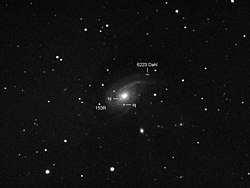Aries (constellation)
Aries is one of the constellations of the zodiac.[3] It is in the Northern Hemisphere. Aries is Latin for ram - a male sheep. Its symbol is ![]() (Unicode ♈), which represents a ram's horns. Aries had the meaning of a ram four thousand years ago in Babylonia. It represents the ram whose fleece (hair) became the Golden Fleece in Ancient Greek Mythology. The astronomer Ptolemy listed Aries when he made a list of 48 constellations.[4]
(Unicode ♈), which represents a ram's horns. Aries had the meaning of a ram four thousand years ago in Babylonia. It represents the ram whose fleece (hair) became the Golden Fleece in Ancient Greek Mythology. The astronomer Ptolemy listed Aries when he made a list of 48 constellations.[4]
 Click for larger image | |
| List of stars in Aries | |
| Abbreviation: | Ari |
| Genitive: | Arietis |
| Symbology: | |
| Right ascension: | 3 h |
| Declination: | +20° |
| Area: | 441 sq. deg. (39th) |
| Main stars: | 4, 9 |
| Bayer/Flamsteed stars: | 67 |
| Stars known to have planets: | 6 |
| Bright stars: | 2 |
| Nearby stars: | 2[a] |
| Brightest star: | α Ari (Hamal) (2.01m) |
| Nearest star: | Teegarden's Star (SO 0253+1652)[1] ( ly) |
| Messier objects: | None |
| Meteor showers: | |
| Bordering constellations: | |
| Visible at latitudes between +90° and −60° Best visible at 21:00 (9 p.m.) during the month of December | |
Aries (constellation) Media
Aries and Musca Borealis as depicted in Urania's Mirror, a set of constellation cards published in London c. 1825
NGC 772, with a notated supernova
References
- ↑ RECONS, The 100 Nearest Star Systems.
- ↑ Thompson & Thompson 2007, pp. 90–91.
- ↑ Kaler, Jim. "THE CONSTELLATIONS". Stars. Retrieved 27 January 2013.
- ↑ "Aries Constellation". Constellation Guide. Retrieved 27 January 2013.
Notes
- ↑ The nearby stars that are named or otherwise known are Teegarden's star and TZ Arietis. The distance can be calculated from their parallax, listed in SIMBAD, by taking the inverse of the parallax and multiplying by 3.26.



